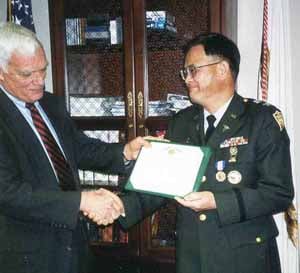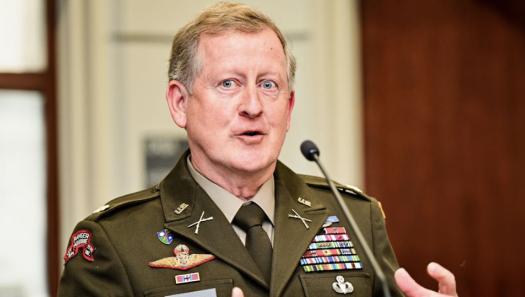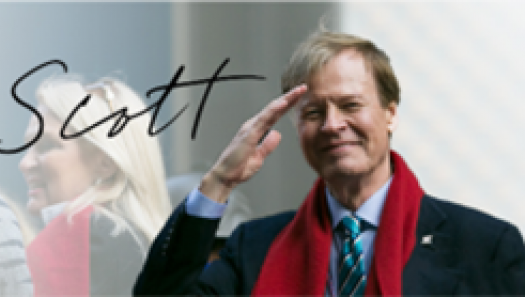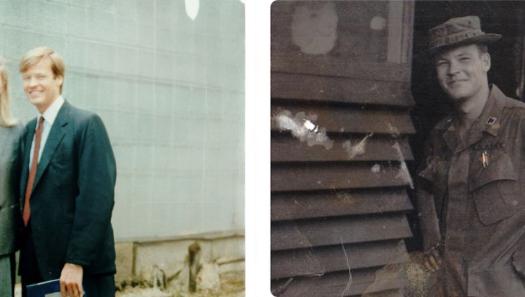Military & Veterans News
Vet News: A Hero on 9/11, Colonel Cites Indignities of Internment During WWII
Rudi Williams, American Forces Press Service

|
|
Army Reserve Col. J. Edgar Wakayama (right) |
If he were alive today, Kinzo Wakayama would be proud of the Soldier’s Medal on his son’s Army uniform.
Though the elder Wakayama suffered years of injustice and indignities in internment camps during World War II, he never let his boys forget they had a duty to serve their country.
Army Colonel J. Edgar Wakayama was awarded the Soldier’s Medal, the Army’s highest decoration for non-combat valor, for his actions at the Pentagon on September 11, 2001.
The Army Medical Service Corps Reservist is on a second one-year tour of duty with the Defense Department’s director for operational test and evaluation.
The award citation reads in part:
"He entered the Pentagon three times to search for injured people, leading three to safety on the first trip and several more on the second attempt, before being repulsed by smoke and heat on the third entry.
"Unable to get inside the Pentagon again, Wakayama started to treat the wounded on-site. He helped perform triage and administer intravenous solutions. He helped the Red Cross set up a blood draw collection point. For the rest of September 11 and for the next nine days, he worked 12-hour shifts at the recovery site."
A Point of Pride
Wakayama said he received the medal on behalf of fire fighters, rescue workers, and soldiers of the 3rd U.S. Infantry (The Old Guard).
Army medics don’t leave wounded soldiers behind, he said. "If we cannot rescue and evacuate them, then we would stay with them even though we were overrun, captured, or even being killed by enemies," he said.
Wakayama doesn’t remember anything about his first home in America, the Manzanar internment camp, between the towns of Lone Pine and Independence in California’s Owens Valley. He was born in the camp and was only 2 when his family was released in late 1945 after three years of imprisonment.
He said he was 18 when "my dad told me about the family experiences just before, during, and post internment. My mother would not talk about it, because it was too painful. My parents may have been bitter, but I don’t really know. My mother tried to erase all bad memories of the internment."
He noted that his parents were American citizens when they were ordered to the internment camp. His father was born in Hawaii and his mother, in California. Wakayama said his father was a World War I Army veteran who served with his brother-in-law, a physician in the Medical Corps."
The order for internment of all persons of Japanese ancestry living in the western half of three Pacific states and the southern third of Arizona came on March 2, 1942, nearly three months after the Japanese attack on Pearl Harbor. More than 110,000 of the 126,000 Japanese Americans living in the United States at that time were incarcerated in tar-papered barracks bounded by barbed wire and machine-gun watchtowers. Two-thirds were American citizens.
"My family lost everything, savings, two cars, their home, furniture and, most of all, their freedom when they were sent to the internment camp," said Wakayama.
Released from Manzanar, his mother and father fled to Japan a few months later with their two sons. Kinzo Wakayama vowed never to return to the United States until he received an official apology for his family’s incarceration. He died in November 1999 in Fukuoka, Japan, at the age of 104.
A Matter of Honor
Even with all the indignities his family suffered and his personal conflict, Kinzo Wakayama told sons Edgar and Carl to return to the country of their birth and serve in the armed forces when they became age 18, even to die for its causes.
"I don’t know what my father told my brother George, who was born in Japan, but he served in the military, too," Wakayama said. "All three of us served in the Army during the Vietnam War. My youngest brother, George, served in Vietnam as a combat engineer." George, too, still wears the uniform: serves in the Air Force Reserve."
In civilian life, George, 54, is a U.S. Customs agent. His brother, Carl, 57, is in the tour business in Hilo, Hawaii. Edgar was born at Manzanar; Carl was born at Tule Lake Internment Camp in California, near the Oregon border.
Wakayama said he was raised in Japan, but as a U.S. Citizen was drafted into the Army in 1967. He received a military deferment to attend Northeastern University in Boston. The colonel was commissioned a second lieutenant through Army ROTC and served a tour of duty in Vietnam. After the war, he earned a master’s degree at the University of Oregon and then a doctorate at the University of Nevada, Reno, where he joined the teaching staff.
When he was interned, Kinzo Wakayama was a lawyer and prominent labor leader in California. With the help of the American Civil Liberties Union, he filed a writ of habeas corpus challenging his family’s unlawful imprisonment. Branded as a troublemaker, harassed and penalized, he gave up and dropped his lawsuit.
However, Edgar took up his father’s battle years later in the form of a letter-writing campaign to convince the government to make amends for what it had done to Japanese Americans during the war.
To Redress a Wrong
"To champion our democracy and freedom, we, the United States of America, must set an example to the rest of the world," Wakayama wrote in a letter to President Reagan. "Until we correct our own wrong done to Americans of Japanese ancestry during World War II, we have no business telling other countries to follow our way of life."
He informed Reagan "that before you tell the Soviet Union to tear down the Berlin Wall or call the Soviets an evil empire, we need to admit and redress our wrong done to Japanese American citizens."
His efforts and the efforts of hundreds more were rewarded when Congress voted to apologize to Japanese Americans interned during World War II. Those still living were granted $20,000 each as a gesture of redress.
Source: American Forces Press Service via Veterans News and Information Service


